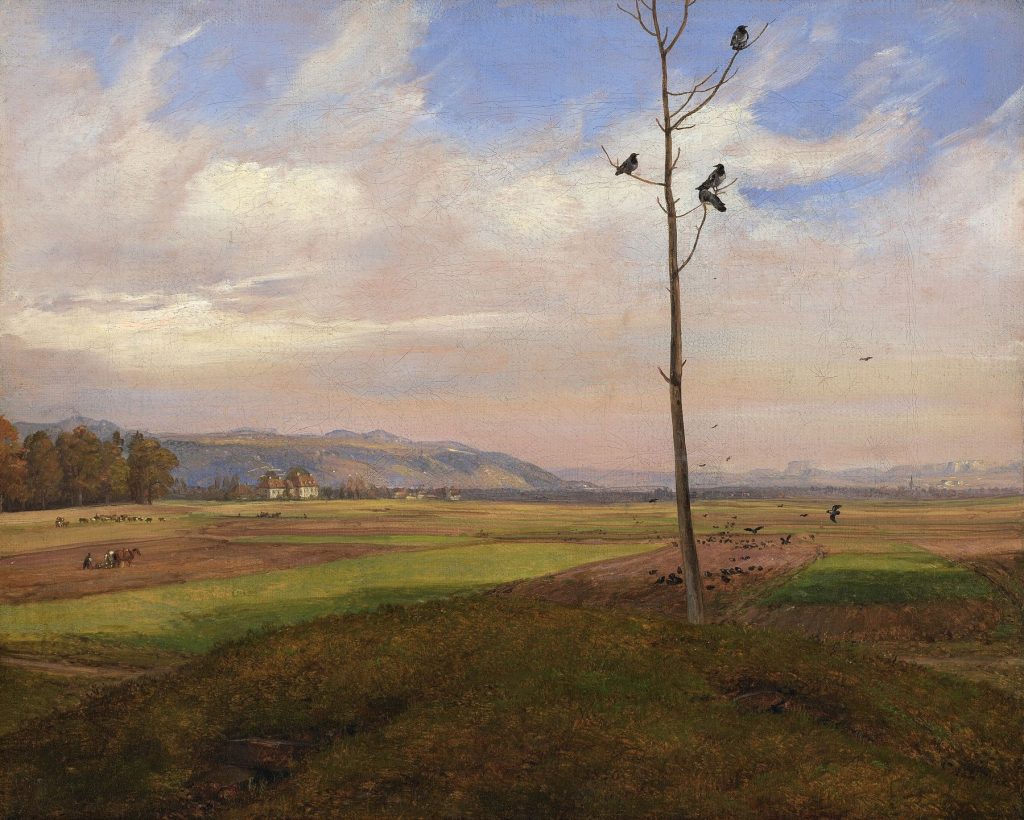Johan Christian Dahl, called Clausen-Dahl (Bergen 1788 - 1857 Dresden)
Landscape near Dresden: View of Kleinzschachwitz and the Mountains of the Saxon Switzerland, 1830
Oil on canvas, 24 x 29.8 cm
Signed and dated lower centre JDahl / 1830
Inscribed on the verso J.C.C. Dahl / Partie bei Dresden / Herbst 1830 and labelled No. 9. Parti ved Dresden. Privat Eiendom. Numbered in red chalk 361
Provenance:
Johan Christian Dahl
General Siegwald Bull (1860-1936), son of Caroline Bull, née Dahl, the artist’s daughter
Dr. I. F. Lorentzen, Nordstrand, Oslo (1937)
Theodor Lorentzen Styr, Oslo (1988)
thence to his daughter
Exhibited:
Katalog over Professor Dahl udstilligen, Christiania Kunstforening, 1907, no. 9
J.C. Dahl’s Verk, Oslo, Kunstnernes Hus, 1937, no. 361
Johan Christian Dahl 1788-1857. Jubileumsutstilling 1988, Oslo, Nasjonalgalleriet and Bergen, Billedgalleri, 1988, no. 124
Literature:
Marie Lødrup Bang, Johan Christian Dahl, 1788-1857. Life and Works, Catalogue Raisonné, Oslo 1987, II, pp.213-14, no. 642; III, fig. 267
We are grateful to Professor Dr. Hans Joachim Neidhardt, Dresden, and Gert Scykalka, Kleinzschachwitz, for their help in identifying the landscape.
Dahl has selected a viewpoint on a hillock north-east of the village of Döbritz in the countryside midway between Dresden and Pillnitz. Today, most of what was once open fields, meadows and woodland has been swallowed up in the sprawl of the city of Dresden. The buildings depicted at the left of the image can be identified – from an 1845 map – as part of a brickworks. Behind the brickworks lies the village of Laubegast. On the other side of the Elbe the distant range of the Borsberg hills forms a backdrop to the plain surrounding Döbritz. At the foot of the Borsberg hills, hidden by the pine forest at Kleinzschachwitz, is Schloss Pillnitz. On the horizon is a glimpse of the low, flat-topped range of the Elbsandsteingebirge and at the right, the massive form of the Lilienstein. The delicately sketched church tower is the tower of the former parish church at Leuben, then a village, now incorporated into the city of Dresden.
The viewer’s eye is led towards a solitary, leafless tree in the right foreground that divides the image according to the rules of the Golden Section. The gaunt form of the dead tree, its bare branches serving as a perch for rooks, underlines the autumnal mood of the painting.
Unlike the work of Caspar David Friedrich, the landscape does not serve as a metaphor for the transient nature of life. Dahl’s landscape is primarily a masterly study of nature. His painterly skill is particularly evident in his handling of the broad expanse of sky and the billowing banks of cloud tinged by the rays of the setting sun.[1]
On his visit to Rome in 1820-1, Dahl came into contact with two French artists, François-Marius Granet and Achille-Etna Michallon. These two artists, working in the tradition of Pierre-Henri de Valenciennes, produced cloud studies that were independent works in their own right. Growing scientific interest in meteorology in early-nineteenth century England encouraged a number of artists to study cloud formations and weather effects in detail. John Constable’s cloud studies are the best-known examples, but artists and thinkers were beginning to show lively interest in the subject in Saxony, too. Goethe himself introduced Dahl’s friend, the physician, scientist and artist C. G. Carus, to the subject. Aubert[2] records that he lent Dahl a copy of Luke Howard’s On the modification of clouds, his key work on cloud formation.[3]
Two versions of this landscape are recorded. One version (Bang 643) was executed as a gift to Advokat A. Kanzler of Hohnstein near Dresden.[4] The other is the present, small-format painting dated 1830[5] which remained in Dahl’s possession. This later passed to his grandson Siegwald Bull via his mother Caroline Bull (née Dahl). There is also a preparatory study (fig. 1.), dated November 1830, which bears a dedication to Adwokat Kansler.
[1] Petra Kipphoff, ‛“Am Himmel ist geschäftige Bewegung.” Die Nord-Süd-Passage oder Johan Christian Dahls Beitrag zur europäischen Wolkenbildung’, in Heinz Spielmann and Ortrud Westheider (eds.), Wolkenbilder. Die Entdeckung des Himmels, exhib. cat., Hamburg, Bucerius Kunst Forum; Berlin, Alte Nationalgalerie; Aarau, Aargauer Kunsthaus, Munich 2004, p.129. [2] Andreas Aubert published two important works on Dahl, a biography in 1894 and an analysis of his paintings in 1920. [3] Marie Lødrup Bang, in Johan Christian Dahl 1788-1857: Ein Malerfreund Caspar David Friedrichs, exhib. cat., Munich, Neue Pinakothek, 1989, p.264. [4] In 1825, Dahl had executed a painting for Kanzler titled Woman and Child Seated under a Fir Tree (Bang 498). It is identical in format. Caroline Louise Kanzler was a witness at the baptism of Dahl’s daughter Caroline in 1822. In a diary entry of the same year Dahl mentions Advokat Kanzler in connection with his father-in-law. See Bang, op.cit., II, p.170. [5] Dahl married his pupil Amalie von Bassewitz in Breslau in January 1830. In December of the same year she was to die giving birth to their son Harald. See Bang, op.cit., I, p.20.


